Solid training
- frida@artyardbklyn.org
- Apr 4
- 14 min read
Updated: Apr 5
Embracing the volatile weather of spring, this week in Advanced Studio in Zoom, AYB Artist Assata Benoit read to us an emotionally charged passage from Zora Neale Hurston’s Their Eyes Were Watching God, asking us to envision and depict an epic storm.

For inspiration Assata shared storm inspired paintings by John Constable, JMW Turner, and Cy Twombly.



Assata wrote within minutes of the session: “I'm a bit blown away by the work from this week's lesson! I'm coming off a high of freshly re-reading the book "Their Eyes Were Watching God", but the class took my idea and ran with it - which is always refreshing. For this lesson, I wanted to keep it simple due to the rich imagery the text evokes. My initial inspiration came to me because I kept relating my daily occurrences to the book.... which I had read 10 years ago in my senior year of high school. Obviously it stuck with my pubescent brain and needed to be brought current in my life.
The storm is a very small part of the book, about 15 pages, but because of its intensity it becomes a massive turning point in the novel. Since the main characters did not leave to reach higher ground in time, Janie, Tea Cake, and the other bean field workers must face the full fury of the hurricane. In their hearts, they realize they are now at the mercy of the storm. They are helpless, unless God intervenes. The hurricane has become a symbol of impersonal, uncontrollable chaos against which human efforts are puny. Their Eyes Were Watching God, but God was already moving on through.
The class did a wonderful job of manifesting the idea of the storm. It is a supernova, it's a tornado that blew through, it's a tropical rain pour - it is natural and inevitable.
Karla’s oil pastel drawing Storm in Kansas is inspired by a photo taken by artist friend Tanner. “I'd never worked with this medium and jumped into the challenge! Thank you Assata!!”
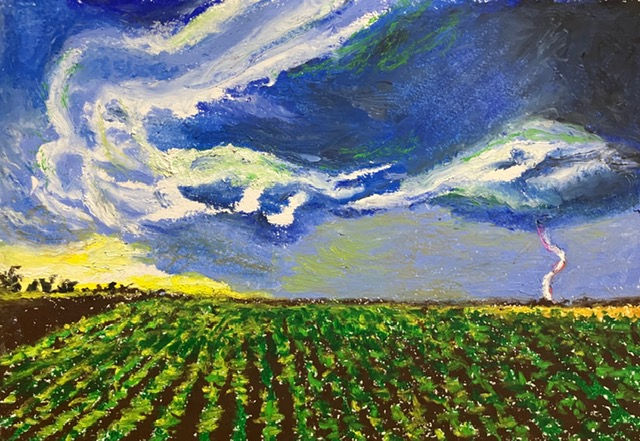
Meridith depicted pounding Roman rain as seen from the window of her studio at The American Academy in Rome.

Travis layers on meaning and concept in his surrealistic interpretation of the eye of a storm!

Richie dove in deep with his illustration of a Brainstorm. “My interpretation of the storm is how the noise in the world makes it harder for your brain/mindset to perceive the island of happiness.”

“It had been the beginning of the storm that had started the drumming. It was an eerie, rhythmic thumping, like the pulse of the world’s heart. The wind beat its wings in time with the thunder. The drumming of the storm was the drumming of her own blood." ~ Zora Neale Hurston
Clearly listening carefully to the story, Vera depicts drummers and dancers as the storm rolls in.

Inspired by Leah’s recent drawing of her illuminated red room, Rachel puts a haze of red over the stormy landscape

Joining us for the first time Gloria worked a soft pastel palette of color into a swirling storm. Gloria writes: “Thank you so much for having me! It was a lovely evening :)”

Ed shows the aftermath of a twister which hit his parents farm causing the huge trees on the property to “appear to be tumbling in a washing machine” as the neighboring farm remained completely unscathed.

Vee Tineo worked in ceramic during the session, and was inspired to create a second drawing later in the week.
Vee Tineo, Storm l & ll
Cheyenne’s dramatic composition and color choice activates her piece!

Lila and Marilyn used watercolor to their best advantage in their stormy scenes.
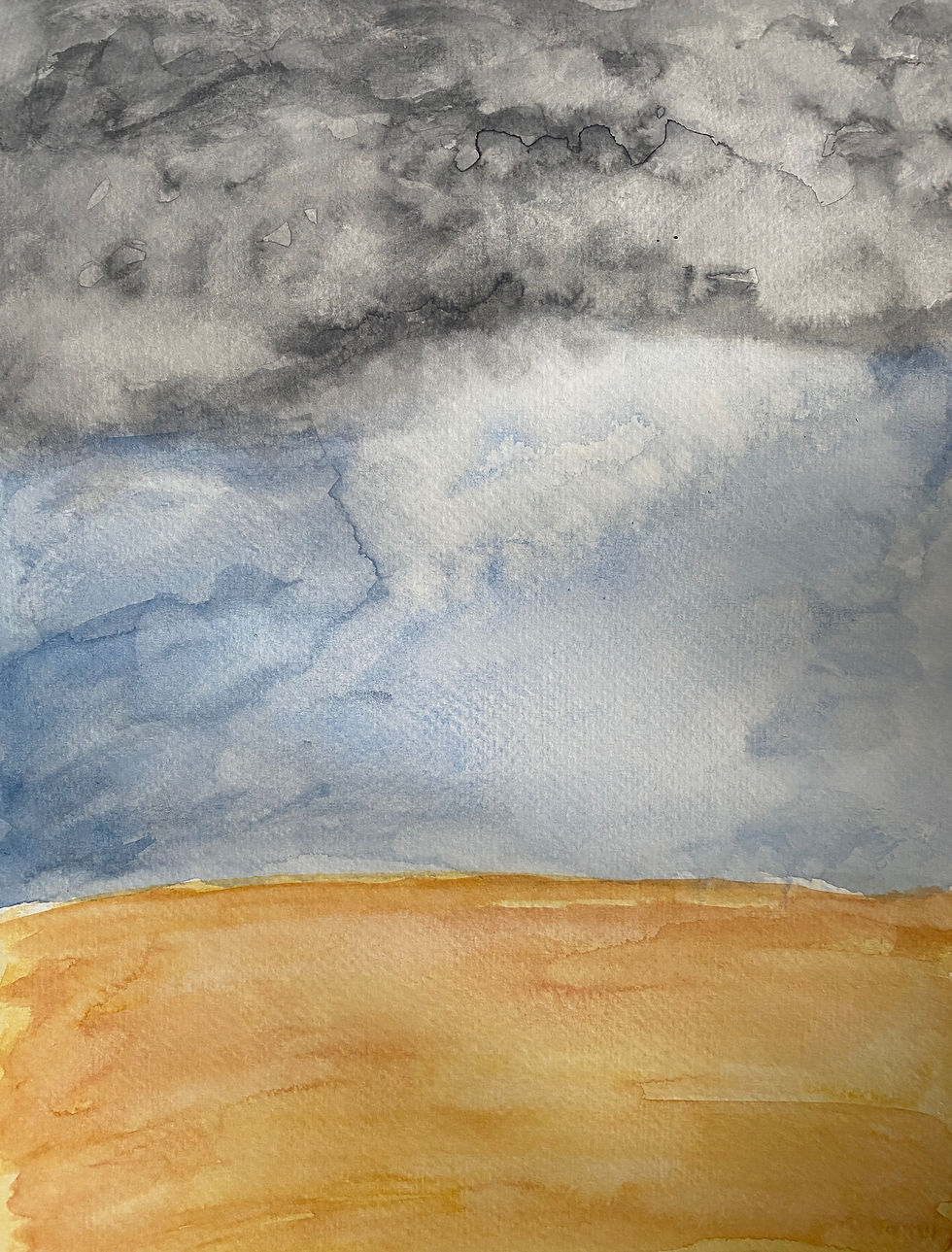

Assata painted in acrylic, focusing on texture and movement in sky and sea.

Scarlett left no color unused in her explosive image!

Adji thought back to our field trip to see Cy Twombly, including text in her vibrant drawing.

Cammi could not locate her paintbrushes, but that didn’t stop her from painting (with her hands!)

In another exceptional use of materials, Clementine manages to make markers look like paint in her diptych.

Assata wraps up: “I am honestly so in love with the artwork made today and hope to see more of us stepping out of our artistic comfort zones!”
Later in the week Assata sent a text as she visited the Brooklyn Museum: “I just came upon this gorgeous painting by José Parlá, and I’m like…. is that my prompt ??! Seriously, I had an emotional reaction, because I was like - wow, this is exactly what I meant.”

In her inaugural teaching session for AYB Advanced Studio in person, intern Clementine Finn who plans to focus her studies next year on Library Science, made good use of her research skills!
Clementine summarizes the lesson: “For my advanced studio lesson I wanted to bring literacy and art together by having the class create an AYB version of the classic kids book “Goodnight Moon” by Margaret Wise Brown. We had a great discussion of the history behind the book, from the Brooklynite woman who wrote it to its surprising absence from the New York Public Library until over 20 years after it was originally published. We had an insightful discussion on book banning and the ideologies behind it, which was made better by the many educators in the room contributing their viewpoints.
Each person then picked a page of the book and set about the task of re-interpreting it.
Adji's cow jumping over the moon shows both how Adji is incredible at overcoming adversity (as she struggled to draw the cow at first) and how she has the power to bring imagery to life dynamically.

Jacob's hula hooping bears match that energy and pair it with a creative placement of the chairs and balloon also mentioned in his passage.

Leah cleverly chose a subdued presence for the topic of her sentence, instead making the focus the setting of the room. She still managed to draw the viewers eye to the brush and the comb using her placement of text within the picture frame.

Scarlett chose to interpret “goodnight nobody” as a way to show her room with no one in it but the plushies and plants that line her shelves. She went above and beyond in her depiction of the room and even pulled out a reference photo to work from.

Liv's two pieces capture the style of the original illustrations, but bring their own life to the story by including fun vivid colors where the original was only black and white. She also took on another page once her first one was done, which was a huge help in completing the book.
Liv Collins, AYB Goodnight Moon
Meridith was inspired by her upcoming exhibition in Small House Galleries in London to draw it for the “little house” page. As always, she was able to capture remarkable detail with her choice of pen and confident linework.

Vee was a late comer to the class, but was able to jump right in and adapt on the fly. Their mouse turned out adorable and commands the viewers attention, leaving the words to be secondary.

Ed brought a fun spin on one of the tougher pages, “a bowl of mush”, in a way that only Ed could. He makes it seem like a tasty late night snack and a fun indulgence with his bright and toony colors.

Elizabeth put her own touch on her page, choosing to depict her abuela's friend Doña Maria in place of the old rabbit. The result is a piece both comforting and nostalgic, with beautiful vivid colors.

Taylor created a bold border that made their page instantly stand out against the others. The limited use of color as well as the prominent placement of the kitten draws the viewer’s attention and makes for a memorable page.

Liana tackled the final page of the book, which was a daunting task that she managed to nail. The first person view of the fire and the window instantly places us in a comforting scene and feels like a perfect place to say goodnight.

Maria brilliantly used clocks and socks together to create curtains on the windows, bringing a sense of fantastical whimsy to the piece that makes the viewer almost feel as though they are in a tiny house. The myriad of detail is impressive and makes the room feel lived in.

Cheyenne created a wonderful rendition of the page about a cat jumping over the moon by referencing the book's Brooklyn roots. The colors used are bold and bright, bringing a sense of fun and harmony that aligns perfectly with other children’s book illustrations.

Brenda referenced our home away from home in BWAC, showing our view of the moon from the window. Ed astutely pointed out that the curve of the bricks around the window calls the viewer to intuitively finish the arc of the moon, which was a great technical detail.

Jazz’s mix of marker and colored pencil lead to a stunning drawing composed of a myriad of brushstrokes that I think perfectly captured the feeling of seeing stars.

Abriel’s reinterpretation of the three bears page was brilliant, calling to mind late night sleepover rituals of storytelling between friends and family. The piece only uses three colors, but uses a variety of shades of those colors that really makes it pop.
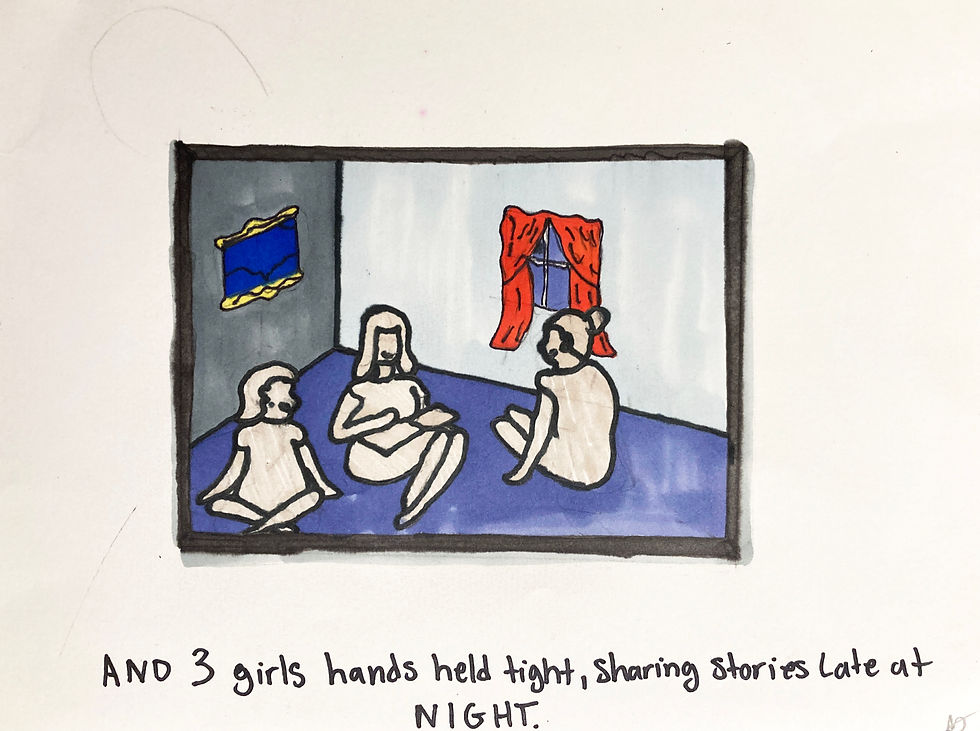
Ajani painstakingly worked on the little details of a shoe rack and how to draw mittens. I (Meridith) managed to miss taking a photo of their completed piece. But here is Ajani in action:

I (Clementine) created three pieces, as we had a few more pages than people in the studio. My first relating to the kittens and mittens was a fun challenge in how to include all four subjects in one frame. My second was an attempt to get creative with lettering, making the goodnight air almost flow as air would. My final one was inspired the view from my table of BWAC, which felt like an appropriate room to say goodnight to as the lesson winded to an end.
Clementine Finn, AYB Goodnight Moon l, ll, & lll
Everyone created amazing work, and I was glad that we could have a great discussion around the book as well!

Dennis and the AYB teaching artists, assistants and interns are making magic happen with ART YARD Art Matters partnerships in the school!
In a new lesson at PS 17, students in Grades 5, 4, and 2 create paintings in the style of The Treachery of Images (This is Not a Pipe) by Rene Magritte.

Evelyn recaps: Dennis, Leo, Scarlett, and I (Evelyn) were on deck to kick off the lesson this week.
In each class, we asked if any of the students speak French, so they could read aloud the original French caption “Ceci n’est pas une pipe.” One student, Miguel, was happy to volunteer and shared that he has spent time living in Madagascar and Paris.

According to LACMA, this iconic painting “challenges the convention of identifying an image of an object as the thing itself. Presented in the style of an advertisement, with the neat cursive text forming a slogan-like caption under the image of the pipe, the painting prompts the viewer to ponder its conflicting messages.”
We set up the room with a variety of still life objects, including vases, cups, and spoons. To reinforce the difference between an image of the thing and the thing itself, I asked students to compare a cup on the table with a photo of the cup I took on my phone. When asked “Is this a cup?” students first responded that yes, the photo of the cup is a cup, but then adjusted their answer as we discussed some crucial differences.
With this in mind, students began to draw the objects on the table. We learned some observational drawing techniques, with a focus on the ellipse—a circle seen from the side. Several of the objects had circular openings, and we discussed how these look different from an angle vs. head-on. Ellipses can be quite challenging to draw, even for college-level art students. When presented with the following, many of our students correctly guessed (B):


Students who finished their drawings added text: “This is not a …” with the name of the object depicted. Some students went the extra mile and learned how to write the sentence in cursive to even more closely match the original Magritte painting.
With most of the drawings complete, we will begin painting with watercolors next week. Students offered comparisons, contrasts, and compliments during a stellar critique conducted by AYB Intern Scarlett!

Dennis adds: “In our afterschool program at PS 17, Teaching Artist Marina Soliman brought the group of 9 students to faraway places - via tree houses. Well, I grew up in Brooklyn so a tree house was a faraway place to me back then (and still is now).


The lesson was a continuation of previous watercolor technique classes with an underlying theme of a fantasy home up in the treetops. Our afterschool group consists of students from various grade levels - this week, Marina paid particular attention to those who needed some guidance with selecting the right sized brushes and using the correct amounts of water.

I learned that we might be adding more students to our class starting next week - so Marina and I discussed a plan (do a review of what we've done - or would that hold our existing students back? - keep moving forward and hoping the new students will jump right in?) but agreed that we can only see how things will progress next Wednesday at 3PM.
Teaching Artist/Muralist Gianinna Gutierrez ("Gia") was just about at the close of the library mural when she got a spurt of creative energy and added even more detail - seen here in the photos. It's hard to photograph the mural in its entirety - I might need to assign this task to a 6th grader - they seem to know every iPhone secret out there.
Teaching Artist Lionel Emabat ("Leo") was a person in motion this week - assisting Evelyn with conducting 4 classes, assisting Marina with teaching afterschool, organizing supplies, setting up and cleaning up the classroom - as well as creating even more drafts and a sample emblem for the school's upcoming Women's History event. He's created drawings representative of many historic women (selected by the school) which students will assist with transferring the 24" paper disks. Smart thinking on Leo's part - he had the drafts laminated (which the school's teachers graciously offered to do) so that they wouldn't be easily destroyed/damaged by having multiple students using them. Leo created a sample disk of Taylor Swift (ummmm .... I guess she's now historic?) - seen here in the first stages of color. Additionally, Gia created a supply list of paint colors left over from her murals which she offered to Leo for this project. All under the AYB umbrella!!

Special mention to our intern, Scarlett, who jumps in and takes action every second of our day - helping with crowd control, having supplies (including water!) ready, offering encouragement, participating in lessons, and excelling in all the other 5 million things interns are expected to do in a school art program. Thanks, Scarlett!

In addition to all of that, Dennis put up a display of recent AYB artwork in the school hallway.
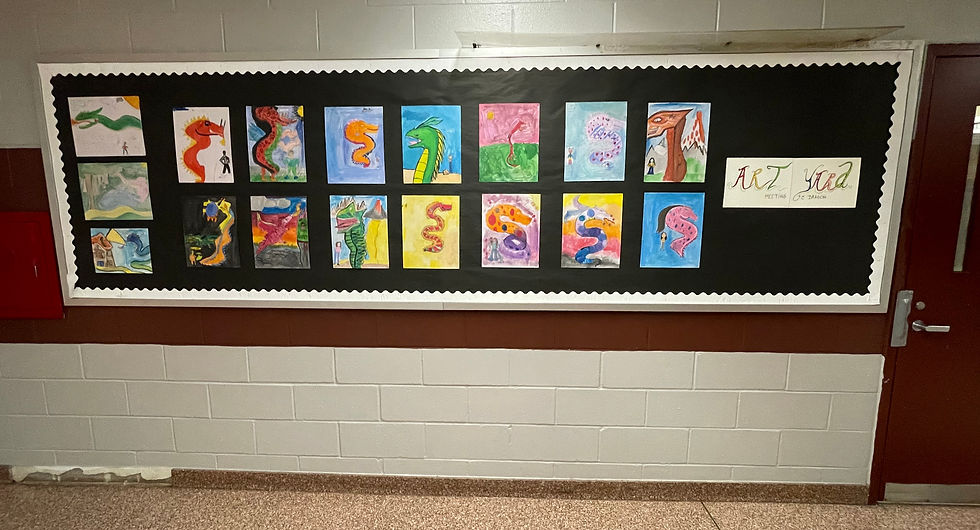
Today in Jersey City at PS 6 students were learning observational portrait drawing, with AYB’s leading portraitist Evelyn Beliveau!
Evelyn recounts the successes of the day: “At PS 6 this week, we started a new lesson called “Portrait of a Friend Reading.” Dennis, Gem, Scarlett, Clementine, and I (Evelyn) worked with students in Grades 5, 3, and 2.

We took inspiration from a painting by Gwen John (1876-1939) of her friend reading a book, Dorelia by Lamplight à Toulouse (1903-1904). Students of all grades learned about portraiture and what it means to draw or paint from observation, and discussed what we can learn or guess about a portrait subject if they are depicted reading. Depending on grade level, some students dove deeper into more context about John’s painting:
“Through her independence, her decision to live alone in Paris, her solid training, and the importance of her female friendships, Gwen John seemed to be the model of a new type of woman at the end of the 19th century … Dorelia by Lamplight à Toulouse (1903-1904) shows the model engrossed in reading Custine’s book. The artist thus broke with the classical depiction of the fragile young girl, and showed us active young women of a new century.” ~ Catherine Gonnard
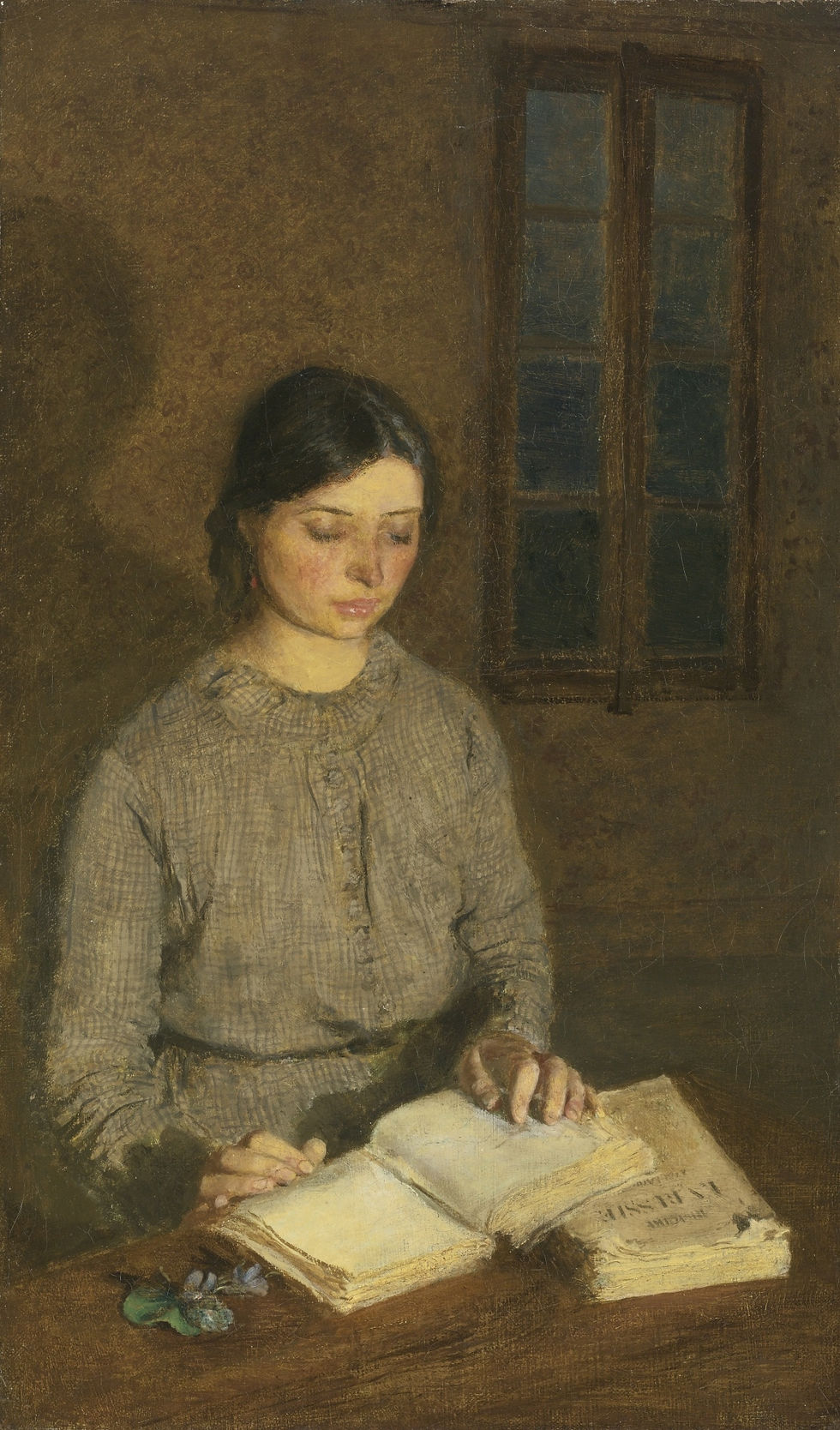
In each class, one or two students generously volunteered to model for their classmates! classmates! Shout-out to Nilan in Grade 5, Pranav in Grade 2, and Anthony and Ethan in Grade 3. Each of these students did an excellent job reading studiously at a chair in the front of the room, and they became the subjects of all the artwork created in class.
We started with a demonstration, then jumped in with pencil on watercolor paper. Students were instructed to draw outlines only, no shading, in preparation for watercolor painting next week.


Portraiture is a challenging subject, and students persevered with difficult details like hands and facial features. We encouraged students to look closely and only draw what they could really see—for example, only the front cover of the book if that was all that was visible, or just one ear if the model appeared at a 3/4 angle. At critique, students compared and contrasted the level of detail included in clothes, hair, and backgrounds, and gave compliments about the likenesses their classmates achieved."

Other Art News
Check out this very cool public art on view in Brooklyn through April 20, 2025!

AYB Artist Vera Brown writes: “This is what happens when art and a nonprofit, Welder Underground, which teaches young adults welding and fabrication, collide. Meet Rappin’ Max Robot, a 18-foot-tall, metal sculpture, located in Columbus Park, near the Court Street stop in Brooklyn. Rappin’ Max Robot was created in the 1980s, by artist Eric Orr, and appeared in the first hip hop comic book. Like AYB, Welder Underground, is bringing the importance of creativity to the world.”
Relating back to Clementine’s Advanced Studio session on Tuesday, have you seen the latest USPS stamp issue?!?

What We Are Reading
In Funny Boy: The Richard Hunt Biography, Jessica Max Stein (Rutger University, 2024) delves into the vibrant life of Richard Hunt, one of the "Original Five" Muppet performers whose humor, energy, and creativity shaped some of the most iconic characters in children’s television. From his early days as a teenage puppeteer to his rise as a key figure in The Muppet Show, Sesame Street, and Fraggle Rock, Hunt’s sharp wit and irreverence brought beloved characters like Beaker, Janice, and Statler to life. Stein highlights how Hunt’s edgy humor helped push the Muppets into more adult-centered territory during the 1970s while showcasing his generosity as a mentor to future generations of performers.
Stein’s biography not only celebrates Hunt’s career but also explores his personal resilience, particularly as he faced the AIDS epidemic, which claimed his partner and threatened his own life. The book captures Hunt's infectious joy, his ability to connect with people from all walks of life, and his unwavering passion for puppetry. I recommend this well researched biography, Richard Hunt was an inspiring artist and mentor to up-and-coming puppeteers!
💗💚💙💛🩵💜🧡❤️🩷




































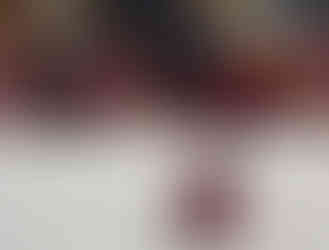









































Yorumlar